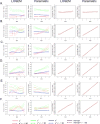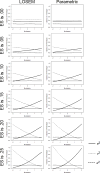Nonparametric Estimates of Gene × Environment Interaction Using Local Structural Equation Modeling
- PMID: 26318287
- PMCID: PMC5374877
- DOI: 10.1007/s10519-015-9732-8
Nonparametric Estimates of Gene × Environment Interaction Using Local Structural Equation Modeling
Abstract
Gene × environment (G × E) interaction studies test the hypothesis that the strength of genetic influence varies across environmental contexts. Existing latent variable methods for estimating G × E interactions in twin and family data specify parametric (typically linear) functions for the interaction effect. An improper functional form may obscure the underlying shape of the interaction effect and may lead to failures to detect a significant interaction. In this article, we introduce a novel approach to the behavior genetic toolkit, local structural equation modeling (LOSEM). LOSEM is a highly flexible nonparametric approach for estimating latent interaction effects across the range of a measured moderator. This approach opens up the ability to detect and visualize new forms of G × E interaction. We illustrate the approach by using LOSEM to estimate gene × socioeconomic status interactions for six cognitive phenotypes. Rather than continuously and monotonically varying effects as has been assumed in conventional parametric approaches, LOSEM indicated substantial nonlinear shifts in genetic variance for several phenotypes. The operating characteristics of LOSEM were interrogated through simulation studies where the functional form of the interaction effect was known. LOSEM provides a conservative estimate of G × E interaction with sufficient power to detect statistically significant G × E signal with moderate sample size. We offer recommendations for the application of LOSEM and provide scripts for implementing these biometric models in Mplus and in OpenMx under R.
Conflict of interest statement
All authors declare that they have no conflict of interest.
Figures







References
-
- Asparouhov T. Sampling weights in latent variable modeling. Struct Equ Modeling. 2005;12(3):411–434.
-
- Benjamin Y, Hochberg Y. Controlling the false discovery rate: A practical and powerful approach to multiple testing. J R Stat Soc Series B Stat Methodol. 1995;57(1):289–300.
-
- Bowman AW. An alternative method of cross-validation for the smoothing of density estimates. Biometrika. 1984;71:353–360.
Publication types
MeSH terms
Grants and funding
LinkOut - more resources
Full Text Sources
Other Literature Sources

